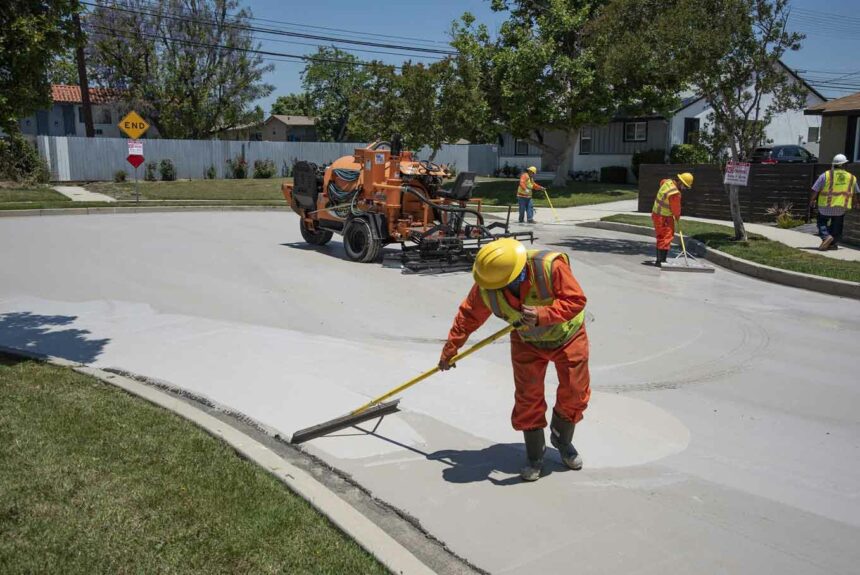Every summer cities undergo the urban heat island effect where hard infrastructure such as pavement and buildings absorb and re-emit the sun’s heat. The urban heat island effect leads to higher temperatures in cities which leads to increased energy use, air pollution, and heat-related illnesses. While there are several tried and tested methods to reduce the heat island effect, such as planting more trees and green space, one new solution has emerged to address the problem: paint.
>>>READ: Want to Alleviate Severe Heat in Cities? Turn to Rooftop Gardens
In April 2021, researchers at Purdue University made a sustainable breakthrough when they invented the world’s “whitest paint.” The ultra-white paint, which reflects up to 98.1% of solar radiation from any given surface, was featured in the 2022 edition of Guinness World Records. The researchers built on their own previous 95.5% reflective paint iteration to create a thinner and lighter formulation. Dr. Xiulin Ruan, professor of mechanical engineering at Purdue University, led the research team.
Reflective paint like the one discovered at Purdue is now being utilized in a number of important urban and commercial projects nationwide. The Los Angeles neighborhood of Pacoima, for instance, partnered with New Jersey-based roofing manufacturer GAF last summer to install reflective coatings in roads, playgrounds, and parking lots across the community.
The initiative, dubbed the GAF Cool Community Project, saw one million square feet of neighborhood streets and parks treated with the radiative material. Since introducing heat-reflective paint to Pacoima, painted surfaces in the L.A. neighborhood have seen their ambient and surface temperatures reduced by 3.5°F and 10°F on extreme heat days, respectively, according to grassroots environmental justice group Pacoima Beautiful. Underserved communities like Pacoima typically suffer from low tree canopy coverage and are more prone to devastating heat islands, so the project is critical in reducing so-called “thermal inequity.”
L.A. isn’t the only city to use heat-reflective paint to cool down temperatures. In Atlanta, GAF donated its innovative paint to the budding SAE School. Meanwhile, the City of Phoenix installed cool pavement on city streets in April to help mitigate scorching hot temperatures in the Valley. In tandem with Arizona State University researchers, city officials found that roads that had been treated with cool pavement experienced surface temperatures 10.5° to 12°F lower during peak daylight hours than traditional asphalt roads. The cool pavement-coated streets revealed cooler surface temperatures at all times of the day compared to conventional asphalt (Phoenix is the hottest and fifth-largest city in the U.S., averaging temperatures of 93.7°F in the summer).
>>>READ: Scientists Create Backyard-Compostable Bioplastic from Algae
In New York City, more than 10 million square feet of rooftops have been coated with reflective white paint since 2009, when the city launched its CoolRoofs program. According to NYC CoolRoofs, reflective rooftops can reduce internal building temperatures by up to 30% and decrease air conditioning costs by 10 to 30% on sweltering summer days. White roof-coated buildings also improve the surrounding air quality and lower greenhouse gas emissions by reducing peak energy demand. By reflecting heat from the Earth’s surface and bouncing it back to space, white roofs further help curb dangerous heat buildup––staving off the formation of urban heat islands. The benefits of boosting reflectivity are particularly pronounced during deadly summer heat waves.
As parts of the world continue getting hotter, covering streets with solar-reflective paint is a simple, yet innovative solution to curb climate change. Lighter land surfaces can lower extreme temperatures not just in cities, but in surrounding rural areas as well. When it comes to thwarting climate change, scientists, innovators, and entrepreneurs are paving the way for a cooler world.
Nathalie Voit is a freelance content creator and a graduate of the University of Florida. She is an alumni of The Heritage Foundation’s Young Leaders Program.
The views and opinions expressed are those of the author’s and do not necessarily reflect the official policy or position of C3.
